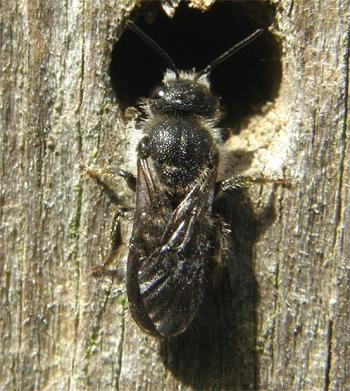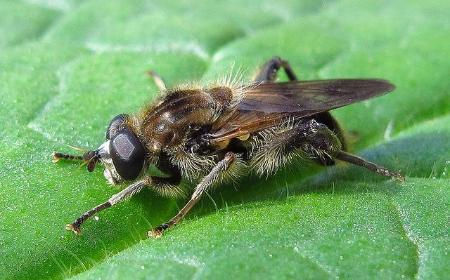Special insects of Shropshire and the Marches
Stelis phaeoptera

The cuckoo bee Stelis phaeoptera is counted amongst the rarest of Britain's native bee species. Remarkably, in Shropshire there is apparently a well established population of this bee. Individuals have been found at Ruyton XI Towns, Craven Arms and in two gardens in Shrewsbury and Bayston Hill. The photo above shows a female searching for nests of its host, the mason bee Osmia leaiana - a widespread bee, frequently found in gardens. The photo was taken by Steven Falk in Nigel Jones' garden, where S. phaeoptera has nested since 2006.
Nigel Jones and Ian Cheeseborough are working with local gardeners to see if more locations for this bee can be discovered in the Shropshire area. A new site near Welshpool has already been discovered.
You can read more about this Shropshire speciality from our Downloads page
Nigel Jones and Ian Cheeseborough are working with local gardeners to see if more locations for this bee can be discovered in the Shropshire area. A new site near Welshpool has already been discovered.
You can read more about this Shropshire speciality from our Downloads page
Chalcosyrphus eunotus

This rare hoverfly was virtually unknown in Britain until the late 1980's. Targeted searching by a few entomologists discovered this secretive fly in a number of locations in the Shropshire and Worcestershire area. There are now a dozen known sites in Shropshire. It has also been discovered in Staffordshire and Herefordshire.
The larvae of C. eunotus live in partly submerged dead wood lying in streams within woodlands. The adult fly (pictured above) has a short flight season from late April to late May and is almost always found resting on deadwood close to or in streams, or on foliage close to streams. Once the habitat requirements and flight times of this elusive fly were understood, it became relatively easy to find new sites for this species. Outside of its Marches stronghold area there are very few known sites, mainly in Wales and south-western England. In Europe as a whole, this remains a little known hoverfly.
C. eunotus has been discovered at around twenty sites in the Marches, with a concentration along the Severn Valley. Sites include:
Shropshire: Coalbrookdale woodlands, Cound Brook woodland, Attingham Park, Habberley Valley woodland, Highley woodlands, west Shropshire woodlands.
Herefordshire: Mortimer Forest and Croft.
Worcestershire: Wyre Forest, Shrawley Wood, Leigh Brook woods.
British distribution map below.
The larvae of C. eunotus live in partly submerged dead wood lying in streams within woodlands. The adult fly (pictured above) has a short flight season from late April to late May and is almost always found resting on deadwood close to or in streams, or on foliage close to streams. Once the habitat requirements and flight times of this elusive fly were understood, it became relatively easy to find new sites for this species. Outside of its Marches stronghold area there are very few known sites, mainly in Wales and south-western England. In Europe as a whole, this remains a little known hoverfly.
C. eunotus has been discovered at around twenty sites in the Marches, with a concentration along the Severn Valley. Sites include:
Shropshire: Coalbrookdale woodlands, Cound Brook woodland, Attingham Park, Habberley Valley woodland, Highley woodlands, west Shropshire woodlands.
Herefordshire: Mortimer Forest and Croft.
Worcestershire: Wyre Forest, Shrawley Wood, Leigh Brook woods.
British distribution map below.
In Staffordshire, Andy Jukes investigated the autecology of C. eunotus. This is described in a downloadable report here.